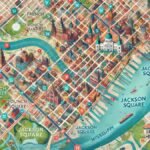New Orleans Zip Code designations offer insight into the city’s geographical layout, history, and unique neighborhoods. Understanding these zip codes is essential for anyone looking to explore or move to this vibrant city. Each zip code represents a different facet of New Orleans’ cultural and residential diversity, making it easier for residents and visitors alike to navigate and understand its rich tapestry.
History of the New Orleans Zip Code System
The New Orleans Zip Code system was introduced as part of a national initiative by the United States Postal Service (USPS) to streamline mail delivery and make it more efficient. First implemented in the 1960s, this system assigns specific numbers to geographical regions. Over time, these zip codes have become more than just numbers—they represent neighborhoods, cultural landmarks, and the historical richness of New Orleans. With a total of around 60 zip codes, New Orleans is split into smaller zones, each contributing to the city’s broader identity.
Key Zip Codes and Their Areas
New Orleans comprises several notable zip codes, each covering specific neighborhoods or areas. The 70130 zip code, for example, covers the French Quarter and parts of the Central Business District, making it one of the most iconic in the city. 70118, on the other hand, is home to Uptown and parts of Carrollton, where you’ll find Tulane and Loyola Universities. These zip codes are critical in defining where businesses, homes, and services are located throughout the city.
Residential vs. Commercial Zones
New Orleans Zip Code areas are divided between residential and commercial zones. Zip codes like 70124 and 70115 primarily consist of residential neighborhoods, offering peaceful, suburban-like settings. On the other hand, zip codes such as 70112 and 70130 cover more commercial and tourist-heavy areas, where the hustle and bustle of daily life includes business centers, hotels, and historic landmarks. Understanding the difference between residential and commercial zip codes helps when planning a move or visit to the city.
Zip Code Breakdown by Neighborhoods
New Orleans’ zip codes are a direct reflection of its neighborhoods:
- 70116: Known for the historic Faubourg Marigny, famous for live music and nightlife.
- 70118: Covers Uptown, where you’ll find lush greenery and old Victorian homes.
- 70119: Encompasses Mid-City, home to Bayou St. John and the New Orleans Fair Grounds.
- 70115: Includes the Garden District, well-known for its stately homes and Southern charm.
Each of these zip codes gives residents and visitors a clear understanding of the vibe and amenities of each neighborhood, making it easier to navigate the city and experience its many flavors.
Tourist Attractions by Zip Code
Many of New Orleans’ most famous tourist attractions can be found within specific zip codes. For instance:
- 70116: Frenchmen Street, filled with live music venues and eclectic art.
- 70130: The French Quarter, Jackson Square, and the lively Bourbon Street.
- 70118: Audubon Park and Zoo, Tulane and Loyola Universities.
These zip codes are vital for travelers planning their itineraries, as each area is packed with cultural landmarks, dining options, and unique experiences.
New Orleans Postal Services Overview
The New Orleans Zip Code system is maintained by the USPS, with each zip code serving specific post offices and mail carriers. Efficient mail delivery is essential in this city, where postal services are utilized by businesses, residents, and visitors alike. In addition to regular mail services, many zip codes house package delivery hubs, ensuring timely receipt of goods. Whether you are sending or receiving mail, knowing your zip code and its corresponding post office is critical.
Impact of Zip Codes on Real Estate and Living
Zip codes in New Orleans significantly influence the real estate market. Properties located in sought-after zip codes such as 70115 (Garden District) or 70124 (Lakeview) are in high demand and tend to have higher property values. In contrast, areas undergoing revitalization, like 70117 (Bywater), offer opportunities for affordable housing and investment. Understanding how New Orleans Zip Code affects real estate prices can help prospective buyers and investors make informed decisions about where to purchase or rent.
The Future of New Orleans Zip Code Areas
As the city continues to evolve, so too do its zip codes. Some areas are seeing rapid development and gentrification, which could lead to changes in zip code boundaries and demographics. Moreover, as new housing projects and commercial ventures spring up, the need for postal realignment and updated services may arise. Keeping an eye on New Orleans’ urban development will offer insights into the future of its zip code system.
Conclusion
New Orleans Zip Code designations offer more than just a postal route—they are a key to understanding the city’s diverse neighborhoods, history, and future. Whether you’re a resident or a visitor, knowing these zip codes is essential for navigating the vibrant and unique cultural landscape of New Orleans. From the historic French Quarter to the peaceful suburbs, the city’s zip codes paint a detailed picture of what makes New Orleans one of the most extraordinary cities in the United States.
For More Visit, Viraltimes.co.uk







